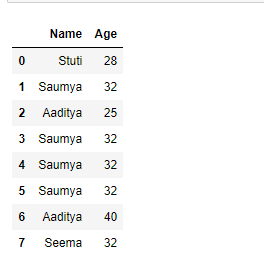使用 [ ]、loc 和 iloc 在 Pandas DataFrame 中按名称或索引选择行和列
Pandas 中的索引意味着从 Dataframe 中选择数据的行和列。它可以选择所有行和特定数量的列、特定数量的行和所有列或每个特定数量的行和列。索引也称为子集选择。
让我们用一个元组列表创建一个简单的数据框,比如列名是:'Name'、'Age'、'City'和'Salary'。
# import pandas
import pandas as pd
# List of Tuples
employees = [('Stuti', 28, 'Varanasi', 20000),
('Saumya', 32, 'Delhi', 25000),
('Aaditya', 25, 'Mumbai', 40000),
('Saumya', 32, 'Delhi', 35000),
('Saumya', 32, 'Delhi', 30000),
('Saumya', 32, 'Mumbai', 20000),
('Aaditya', 40, 'Dehradun', 24000),
('Seema', 32, 'Delhi', 70000)
]
# Create a DataFrame object from list
df = pd.DataFrame(employees,
columns =['Name', 'Age',
'City', 'Salary'])
# Show the dataframe
df
输出: 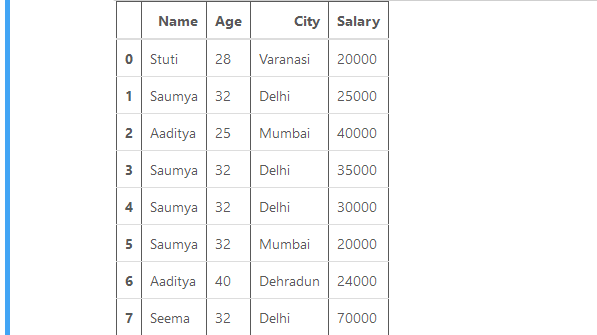
方法一:使用Dataframe.[]。
[ ]用于通过提及相应的列名来选择列。
示例 1:选择单列。
代码:
# import pandas
import pandas as pd
# List of Tuples
employees = [('Stuti', 28, 'Varanasi', 20000),
('Saumya', 32, 'Delhi', 25000),
('Aaditya', 25, 'Mumbai', 40000),
('Saumya', 32, 'Delhi', 35000),
('Saumya', 32, 'Delhi', 30000),
('Saumya', 32, 'Mumbai', 20000),
('Aaditya', 40, 'Dehradun', 24000),
('Seema', 32, 'Delhi', 70000)
]
# Create a DataFrame object from list
df = pd.DataFrame(employees,
columns =['Name', 'Age',
'City', 'Salary'])
# Using the operator []
# to select a column
result = df["City"]
# Show the dataframe
result
输出: 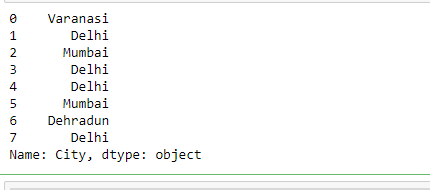
示例 2:选择多个列。
代码:
# import pandas
import pandas as pd
# List of Tuples
employees = [('Stuti', 28, 'Varanasi', 20000),
('Saumya', 32, 'Delhi', 25000),
('Aaditya', 25, 'Mumbai', 40000),
('Saumya', 32, 'Delhi', 35000),
('Saumya', 32, 'Delhi', 30000),
('Saumya', 32, 'Mumbai', 20000),
('Aaditya', 40, 'Dehradun', 24000),
('Seema', 32, 'Delhi', 70000)
]
# Create a DataFrame object from list
df = pd.DataFrame(employees,
columns =['Name', 'Age',
'City', 'Salary'])
# Using the operator [] to
# select multiple columns
result = df[["Name", "Age", "Salary"]]
# Show the dataframe
result
输出: 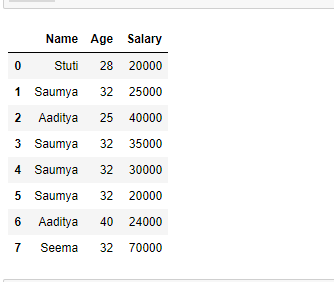
方法 2:使用 Dataframe.loc[ ]。
.loc[]函数通过行或列的标签选择数据。它可以选择行和列的子集。有很多方法可以使用这个函数。
示例 1:选择单行。
代码:
# import pandas
import pandas as pd
# List of Tuples
employees = [('Stuti', 28, 'Varanasi', 20000),
('Saumya', 32, 'Delhi', 25000),
('Aaditya', 25, 'Mumbai', 40000),
('Saumya', 32, 'Delhi', 35000),
('Saumya', 32, 'Delhi', 30000),
('Saumya', 32, 'Mumbai', 20000),
('Aaditya', 40, 'Dehradun', 24000),
('Seema', 32, 'Delhi', 70000)
]
# Create a DataFrame object from list
df = pd.DataFrame(employees,
columns =['Name', 'Age',
'City', 'Salary'])
# Set 'Name' column as index
# on a Dataframe
df.set_index("Name", inplace = True)
# Using the operator .loc[]
# to select single row
result = df.loc["Stuti"]
# Show the dataframe
result
输出: 
示例 2:选择多行。
代码:
# import pandas
import pandas as pd
# List of Tuples
employees = [('Stuti', 28, 'Varanasi', 20000),
('Saumya', 32, 'Delhi', 25000),
('Aaditya', 25, 'Mumbai', 40000),
('Saumya', 32, 'Delhi', 35000),
('Saumya', 32, 'Delhi', 30000),
('Saumya', 32, 'Mumbai', 20000),
('Aaditya', 40, 'Dehradun', 24000),
('Seema', 32, 'Delhi', 70000)
]
# Create a DataFrame object from list
df = pd.DataFrame(employees,
columns =['Name', 'Age',
'City', 'Salary'])
# Set index on a Dataframe
df.set_index("Name",
inplace = True)
# Using the operator .loc[]
# to select multiple rows
result = df.loc[["Stuti", "Seema"]]
# Show the dataframe
result
输出: 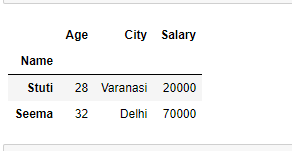
示例 3:选择多行和特定列。
Syntax: Dataframe.loc[["row1", "row2"...], ["column1", "column2", "column3"...]]代码:
# import pandas
import pandas as pd
# List of Tuples
employees = [('Stuti', 28, 'Varanasi', 20000),
('Saumya', 32, 'Delhi', 25000),
('Aaditya', 25, 'Mumbai', 40000),
('Saumya', 32, 'Delhi', 35000),
('Saumya', 32, 'Delhi', 30000),
('Saumya', 32, 'Mumbai', 20000),
('Aaditya', 40, 'Dehradun', 24000),
('Seema', 32, 'Delhi', 70000)
]
# Create a DataFrame object from list
df = pd.DataFrame(employees,
columns =['Name', 'Age',
'City', 'Salary'])
# Set 'Name' column as index
# on a Dataframe
df.set_index("Name", inplace = True)
# Using the operator .loc[] to
# select multiple rows with some
# particular columns
result = df.loc[["Stuti", "Seema"],
["City", "Salary"]]
# Show the dataframe
result
输出: 
示例 4:选择具有某些特定列的所有行。我们使用单冒号 [:] 来选择我们想要选择的所有行和列列表,如下所示:
Syntax: Dataframe.loc[[:, ["column1", "column2", "column3"]]代码:
# import pandas
import pandas as pd
# List of Tuples
employees = [('Stuti', 28, 'Varanasi', 20000),
('Saumya', 32, 'Delhi', 25000),
('Aaditya', 25, 'Mumbai', 40000),
('Saumya', 32, 'Delhi', 35000),
('Saumya', 32, 'Delhi', 30000),
('Saumya', 32, 'Mumbai', 20000),
('Aaditya', 40, 'Dehradun', 24000),
('Seema', 32, 'Delhi', 70000)
]
# Creating a DataFrame object from list
df = pd.DataFrame(employees,
columns =['Name', 'Age',
'City', 'Salary'])
# Set 'Name' column as index
# on a Dataframe
df.set_index("Name", inplace = True)
# Using the operator .loc[] to
# select all the rows with
# some particular columns
result = df.loc[:, ["City", "Salary"]]
# Show the dataframe
result
输出: 
方法 3:使用 Dataframe.iloc[ ]。
iloc[ ]用于基于位置的选择。它类似于 loc[] 索引器,但它只需要整数值来进行选择。
示例 1:选择单行。
代码:
# import pandas
import pandas as pd
# List of Tuples
employees = [('Stuti', 28, 'Varanasi', 20000),
('Saumya', 32, 'Delhi', 25000),
('Aaditya', 25, 'Mumbai', 40000),
('Saumya', 32, 'Delhi', 35000),
('Saumya', 32, 'Delhi', 30000),
('Saumya', 32, 'Mumbai', 20000),
('Aaditya', 40, 'Dehradun', 24000),
('Seema', 32, 'Delhi', 70000)
]
# Create a DataFrame object from list
df = pd.DataFrame(employees,
columns =['Name', 'Age',
'City', 'Salary'])
# Using the operator .iloc[]
# to select single row
result = df.iloc[2]
# Show the dataframe
result
输出: 
示例 2:选择多行。
代码:
# import pandas
import pandas as pd
# List of Tuples
employees = [('Stuti', 28, 'Varanasi', 20000),
('Saumya', 32, 'Delhi', 25000),
('Aaditya', 25, 'Mumbai', 40000),
('Saumya', 32, 'Delhi', 35000),
('Saumya', 32, 'Delhi', 30000),
('Saumya', 32, 'Mumbai', 20000),
('Aaditya', 40, 'Dehradun', 24000),
('Seema', 32, 'Delhi', 70000)
]
# Create a DataFrame object from list
df = pd.DataFrame(employees,
columns =['Name', 'Age',
'City', 'Salary'])
# Using the operator .iloc[]
# to select multiple rows
result = df.iloc[[2, 3, 5]]
# Show the dataframe
result
输出: 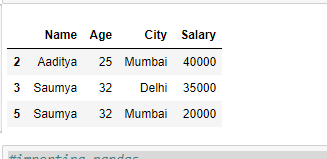
示例 3:选择具有某些特定列的多行。
代码:
# import pandas
import pandas as pd
# List of Tuples
employees = [('Stuti', 28, 'Varanasi', 20000),
('Saumya', 32, 'Delhi', 25000),
('Aaditya', 25, 'Mumbai', 40000),
('Saumya', 32, 'Delhi', 35000),
('Saumya', 32, 'Delhi', 30000),
('Saumya', 32, 'Mumbai', 20000),
('Aaditya', 40, 'Dehradun', 24000),
('Seema', 32, 'Delhi', 70000)
]
# Creating a DataFrame object from list
df = pd.DataFrame(employees,
columns =['Name', 'Age',
'City', 'Salary'])
# Using the operator .iloc[]
# to select multiple rows with
# some particular columns
result = df.iloc[[2, 3, 5],
[0, 1]]
# Show the dataframe
result
输出: 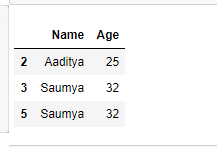
示例 4:选择具有某些特定列的所有行。
代码:
# import pandas
import pandas as pd
# List of Tuples
employees = [('Stuti', 28, 'Varanasi', 20000),
('Saumya', 32, 'Delhi', 25000),
('Aaditya', 25, 'Mumbai', 40000),
('Saumya', 32, 'Delhi', 35000),
('Saumya', 32, 'Delhi', 30000),
('Saumya', 32, 'Mumbai', 20000),
('Aaditya', 40, 'Dehradun', 24000),
('Seema', 32, 'Delhi', 70000)
]
# Create a DataFrame object from list
df = pd.DataFrame(employees,
columns =['Name', 'Age',
'City', 'Salary'])
# Using the operator .iloc[]
# to select all the rows with
# some particular columns
result = df.iloc[:, [0, 1]]
# Show the dataframe
result
输出: 